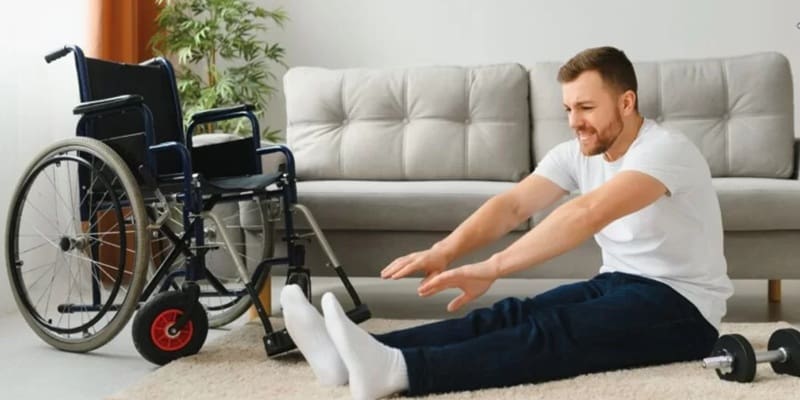
Non-Surgical Blog
Healing Power: Stem Cell Injections for Spinal Cord Injuries
June 4, 2025

- Stem cell injections are emerging as a potential treatment for spinal cord injuries (SCI), offering hope for improved recovery.
- SCI disrupts the communication pathway within the nervous system, leading to motor and sensory impairments.
- Mesenchymal stem cells (MSCs), known for their regenerative capabilities, are being explored for their potential to repair damaged spinal cord tissue.
- While clinical trials show promise, stem cell therapy for SCI is still in its early stages.
Spinal cord injuries (SCI) present a significant medical challenge, often resulting in life-altering consequences. While traditional treatments primarily focus on managing symptoms and improving quality of life, stem cell therapy has emerged as a potential avenue for treatment of SCI. This approach aims to regenerate damaged tissue and restore lost neurological function, offering new hope for individuals living with SCI.
Understanding Spinal Cord Injuries and Their Impact
The spinal cord, a vital part of the central nervous system, acts as the primary communication pathway between the brain and the rest of the body. Injuries to this bundle of nerves can have a devastating impact, leading to loss of motor function, sensory impairment, and other complications.
Depending on the severity and location of the injury, individuals with SCI can experience a wide range of challenges, affecting their mobility, sensation, bowel and bladder control, and overall well-being. This often necessitates long-term care, impacting not only the individual’s life but also that of their families and caregivers.
The Anatomy of the Spinal Cord and Injury Mechanisms
The spinal cord is a cylindrical structure composed of delicate nervous tissue that extends from the brainstem down the vertebral column. It’s responsible for transmitting signals between the brain and the body, controlling essential functions like movement and sensation.
Injury mechanisms often involve forceful impacts or compression to the spinal column, such as those experienced during car accidents, falls, or sports-related trauma. These events can cause bruising, tearing, or severing of the spinal cord, disrupting the flow of nerve signals and leading to a range of neurological deficits.
The extent of these deficits largely depends on the location and severity of the damage to the spinal cord. Injuries higher on the spinal cord, such as those in the cervical region, often result in more extensive paralysis, affecting both the arms and legs (tetraplegia). Injuries lower down, in the thoracic or lumbar regions, typically affect the legs and lower body (paraplegia).
Statistics on Spinal Cord Injuries in the United States
Each year in the United States, approximately 17,000 new cases of spinal cord injuries are reported, highlighting the significant impact of these devastating events on individuals and society. The leading causes of these injuries underscore the importance of safety measures and preventative efforts in various aspects of life.
| Cause of Injury | Percentage |
| Motor Vehicle Accidents | 38% |
| Falls | 32% |
| Acts of Violence | 14% |
| Sports and Recreation | 9% |
| Other Causes | 7% |
The economic burden associated with spinal cord injuries is substantial. Lifetime costs for individuals with SCI can range from millions of dollars, encompassing medical expenses, rehabilitation, and assistive devices. This emphasizes the need for continued research and development of innovative treatment options to improve outcomes and reduce the long-term impact of SCI.
The Science Behind Stem Cell Injections for SCI
Stem cell injections have garnered significant attention as a potential treatment for spinal cord injuries. Stem cells possess the remarkable ability to differentiate into various cell types, including those found in the nervous system. This unique characteristic makes them a promising candidate for repairing damaged spinal cord tissue and potentially restoring lost neurological function.
The rationale behind this approach is grounded in the idea that stem cells, when introduced into the injured spinal cord, can help create a more favorable environment for regeneration. They can potentially achieve this by differentiating into new nerve cells, promoting the growth of surviving nerve fibers, modulating the inflammatory response, and reducing the formation of scar tissue that can hinder recovery.
Types of Stem Cells Used in Treatment
Different types of stem cells are being investigated for their potential in spinal cord injury treatment. Each type has its unique characteristics and potential advantages, making them suitable for specific therapeutic approaches:
- Pluripotent Stem Cells (PSCs) These cells hold the remarkable ability to differentiate into any cell type in the body, making them a versatile source for generating various cell types relevant to spinal cord repair. However, their pluripotency also raises concerns about the potential for uncontrolled growth and tumor formation, necessitating careful regulation and differentiation protocols.
- Mesenchymal Stem Cells (MSCs) MSCs are a type of adult stem cell found in various tissues, including bone marrow and adipose tissue. Known for their ability to differentiate into a range of cell types, including bone, cartilage, and muscle cells, MSCs have also shown promise in preclinical studies for their potential to promote nerve regeneration and reduce inflammation.
- Neural Stem Cells (NSCs) These stem cells are specifically found in the nervous system and have the inherent ability to differentiate into neurons and glial cells, the building blocks of the spinal cord.
How Stem Cells Promote Healing and Regeneration
Stem cell treatment aims to harness the regenerative potential of these cells to repair damaged spinal cord tissue and promote functional recovery. The mechanisms by which stem cells exert their therapeutic effects are multifaceted:
- Cell Replacement: Stem cells can differentiate into various cell types, potentially replacing lost neurons and glial cells crucial for nerve signal transmission. While complete replacement of all damaged cells may not be feasible, even partial replacement could contribute to restoring some degree of function.
- Neurotrophic Factor Secretion: Stem cells are known to release a variety of growth factors that support the survival, growth, and differentiation of nerve cells. These neurotrophic factors can create a more favorable environment for nerve regeneration, potentially leading to the formation of new connections and functional recovery.
- Immunomodulatory Effects: Inflammation plays a significant role in secondary damage after spinal cord injury. Stem cells possess immunomodulatory properties, meaning they can influence the immune response and help dampen inflammation, potentially reducing further damage to the spinal cord and promoting healing.
Evaluating the Effectiveness of Stem Cell Therapy for SCI
The field of stem cell therapy for SCI is rapidly evolving, with numerous clinical trials underway to assess its safety and efficacy. While results have been encouraging, with some patients experiencing improvements in motor and sensory function, it’s essential to acknowledge that the field is still in its early stages, and more research is needed to establish standardized treatment protocols and fully understand the long-term effects.
Moreover, the heterogeneity of SCI, with varying levels of injury severity, location, and individual patient characteristics, adds complexity to the evaluation process. Standardized assessments are crucial to measure improvements in motor function, sensory perception, and overall quality of life, allowing for objective evaluation of treatment efficacy.
Recent Clinical Trials and Their Outcomes
Several clinical trials have been conducted globally to evaluate the safety and efficacy of stem cell therapy for SCI. While most trials are in their early phases (Phase I and II), focusing primarily on establishing safety profiles, promising results have emerged, suggesting potential therapeutic benefits.
One such trial conducted at the University of California, San Diego, involved transplanting neural stem cells into patients with chronic SCI. The study reported encouraging results, with some patients experiencing improvements in motor function, including regaining the ability to move their limbs or improve their walking ability.
Despite these promising findings, it’s important to note that larger, well-designed clinical trials with longer follow-up periods are necessary to confirm these initial observations and optimize treatment protocols. Researchers are actively working to identify the most effective stem cell sources, dosages, and delivery methods to maximize therapeutic benefits and refine treatment strategies.
Final Thoughts
Stem cell injections offer a promising avenue for healing spinal cord injuries. By leveraging the regenerative potential of stem cells, this therapy aims to restore function and improve quality of life for those affected. Recent clinical trials and patient success stories underscore the effectiveness of stem cell treatments in achieving significant milestones. While risks exist, the potential benefits far outweigh them.
If you or a loved one is grappling with a spinal cord injury, consider exploring the transformative possibilities of stem cell therapy. Reach out to learn more and embark on a journey towards healing and hope.
Frequently Asked Questions
What makes stem cell injections a promising treatment for SCI?
Stem cell injections are a promising treatment for SCI because of their unique ability to potentially reduce immune rejection by releasing growth factors, which aid in regulating the body’s natural defense mechanisms.
Are there any risks associated with stem cell therapy for spinal cord injuries?
As with any medical procedure, stem cell therapy for spinal cord injuries carries potential risks. These can include tumor formation, an adverse immune response, or unsuccessful cell integration.
How long does it take to see improvements after receiving stem cell injections?
The time frame for seeing improvements after stem cell injections varies. It depends on the individual, the injury’s severity, and the treatment response. It may take weeks to months for the injected stem cells to integrate into the neural tissue, release neurotrophic factors, and begin the repair process.

Search our blog posts: